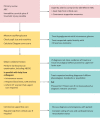A systematic approach to the unconscious patient
- PMID: 29436445
- PMCID: PMC6330912
- DOI: 10.7861/clinmedicine.18-1-88
A systematic approach to the unconscious patient
Abstract
Unconscious patients are commonly seen by physicians. They are challenging to manage and in a time sensitive condition, a systematic, team approach is required. Early physiological stability and diagnosis are necessary to optimise outcome. This article focuses on unconscious patients where the initial cause appears to be non-traumatic and provides a practical guide for their immediate care.
Keywords: Unconscious; coma; drug toxicity; hypoglycaemia; neurological injury.
© Royal College of Physicians 2018. All rights reserved.
Figures
References
-
- Joint Royal Colleges of Physicians Training Board Specialty training curriculum for Acute Internal Medicine. London:: JRCPTB; 2009. (amendments August 2012).
-
- Joint Royal Colleges of Physicians Training Board Specialty training curriculum for General Internal Medicine. London:: JRCPTB; 2009. (amendments August 2012).
-
- Wijdicks E. The bare essentials. Pract Neurol. 2010;10:51–60. - PubMed
-
- Edlow J. Rabinstein A. Traub S. Wijdicks E. Diagnosis of reversible causes of coma. Lancet. 2014;384:206476. - PubMed
-
- Cooksley T. Holland M. The management of coma. Medicine. 2017;45:115–19.
MeSH terms
LinkOut - more resources
Full Text Sources
Other Literature Sources


